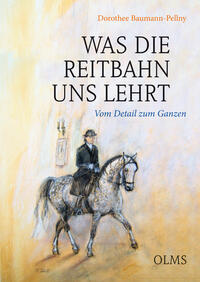
"Ziel wirklichen Reitens ist: innere Zwiesprache mit dem Pferd“, sagt Dorothee Baumann-Pellny. Doch in ihrem Alltag als Reitlehrerin erlebt sie oft das Gegenteil, denn Details werden als unwichtig übergangen oder sind gar nicht bekannt, selbst in der Fachliteratur werden sie kaum thematisiert. Dieses Buch schärft systematisch die Aufmerksamkeit für Feinheiten, die unscheinbar wirken mögen, jedoch der Schlüssel zu erstaunlichen Leistungen von Pferd und Reiter sind. Die eindrückliche Beschreibung von Hilfengebung und Bewegungsabläufen erlaubt es dem Leser, in Gedanken „mitzureiten“ und so die Zusammenhänge der Reitlehre zu verinnerlichen – von den Grundlagen bis hin zum Schulgalopp. Ein umfangreicher Fototeil dokumentiert die sorgfältige Grundausbildung des Araberwallachs „Siwango“ und verdeutlicht wichtige Momente in der Entwicklung einer Reiter-Pferd-Dyade. Eine empathische Arbeit mit dem Pferd fordert dem Menschen nicht nur reiterliche Fähigkeiten, sondern Selbstdisziplin und Reife ab. Die Autorin zeigt Wege auf, wie der Reiter auch in unseren schnelllebigen Zeiten zu Muße, Hingabe und Konzentration finden kann. So schult die Reitbahn die Verständigung mit dem Pferd und die Persönlichkeit des Menschen gleichermaßen. Ein außergewöhnliches Lehrbuch für Reiter wie Ausbilder!****************Baumann-Pellny, Reiten “The goal of true riding is an inner dialogue with the horse,” says Dorothee Baumann-Pellny. But in her everyday work as a riding teacher she often experiences the opposite, seeing fine details ignored as unimportant or simply not recognised. Even in the literature on the topic they are seldom a theme. This book systematically sharpens the attention to those fine details that may seem inconspicuous but are nonetheless the key to amazing achievements by both horse and rider. The impressive description of riding aids and sequences of movements allow the reader to “ride alongside” in their mind and thus to internalise the interrelationships in the theory of riding – from the basics to the school canter. An extensive section of photographs documents the careful training of the Arab gelding “Siwango” and captures important moments in the development of the rider-horse dyad. Working empathetically with a horse demands of the rider not only technical ability but also self-discipline and maturity. The author demonstrates ways in which riders, even in our own fast-paced times, can find time for relaxation, commitment and concentration. In this way the riding-school teaches an understanding with the horse while at the same time training the rider’s personality. An exceptional textbook for both riders and trainers!